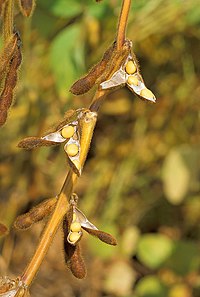
Photo from wikipedia
Soybean is a crop in high demand, in particular as a crucial source of plant protein. As a short-day plant, soybean is sensitive to the latitude of the growing site.… Click to show full abstract
Soybean is a crop in high demand, in particular as a crucial source of plant protein. As a short-day plant, soybean is sensitive to the latitude of the growing site. Consequently, varieties that are well adapted to higher latitudes are required to expand the cultivation. In this study, we employed 50 soybean genotypes to perform a multi-location trial at seven locations across Germany in 2021. Two environmental target regions were determined following the latitude of the locations. Adaptation and trait stability of seed yield and protein content across all locations were evaluated using Genotype plus Genotype-by-Environment (GGE) biplots and Shukla’s stability variance. We found a moderate level of crossing-over type genotype-by-location interaction across all locations. Within the environmental target regions, the genotype-by-location interaction could be minimised. Despite the positive correlation (R = 0.59) of seed yield between the environmental target regions and the same best-performing genotype, the genotype rankings differed in part substantially. In conclusion, we found that soybean can be grown at a wide range of latitudes across Germany. However, the performance of genotypes differed between the northern and southern locations, with an 18.8% higher mean yield in the south. This in combination with the observed rank changes of high-performing genotypes between both environmental target regions suggests that selection targeted towards environments in northern Germany could improve soybean breeding for those higher latitude regions.
Journal Title: Plants
Year Published: 2023
Link to full text (if available)
Share on Social Media: Sign Up to like & get
recommendations!